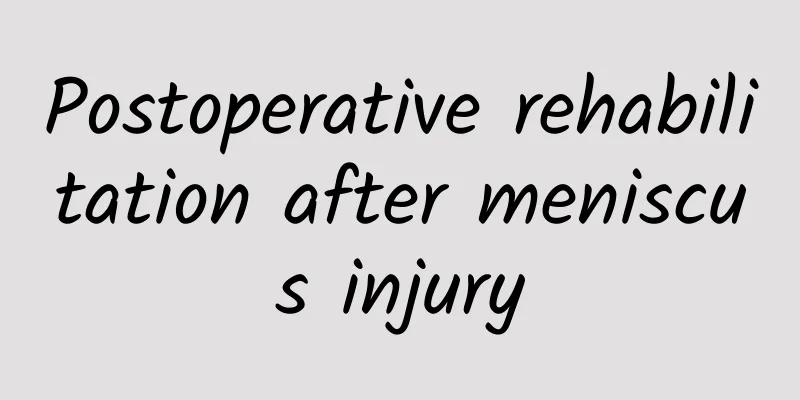Postoperative rehabilitation after meniscus injury

|
Meniscus injury is one of the most common forms of knee injury in sports injuries. Meniscus tear can cause persistent pain, local swelling, biomechanical changes and movement dysfunction. Meniscal repair surgery often needs to consider many factors, including the patient's age, activity level, and whether the tear is chronic, the location, and type. The meniscus is often divided into three zones based on its blood supply (red-red zone, red-white zone, and white-white zone). Given that the blood supply of the meniscus varies in different parts, the blood supply is richest in the periphery of the meniscus, while the blood supply is the least in the center of the meniscus, where there are basically no blood vessels. Tears in the red-red zone have the richest blood supply and are most likely to heal after repair. Tears in the white-white zone are unlikely to heal after repair due to the minimal blood supply, and partial meniscectomy is the best treatment option. The treatment of tears in the red-white zone is controversial, and whether repair is needed depends on the age and needs of the patient and the type and location of the tear. Indications ●Acute meniscal tear in the red-red area or red-white area. ●Full-thickness tear of at least 5 to 10 mm. ●Relatively young and active patients. Contraindications ● Meniscus tear in the white-white area. ●Patients with advanced osteoarthritis. ●Chronic degenerative tear. ●Elderly and less active patients. The rehabilitation program after meniscal repair varies depending on the type and location of the meniscal repair. For example, patients with relatively stable peripheral vertical tears recover faster than those with unstable radial tears. Functional goals and limitations Goals for the first 2 weeks after surgery include controlling pain and swelling, starting knee range of motion, and restoring quadriceps activity. From 2 to 6 weeks after surgery, patients still need to use a hinged knee brace, but can begin to increase knee flexion range of motion training to 90 degrees and begin strength training. At 6 weeks after surgery and beyond, patients can gradually remove the brace and continue to resume full range of motion and strength training. Usually around 3 months after surgery, patients can begin to resume uniaxial sports (such as cycling, running); around 6 months after surgery, patients can begin knee rotation exercises. Rehabilitation goals can be broken down into the following stages. Phase 1: Control swelling and relieve symptoms (0-2 weeks) ●Control swelling with ice and compression therapy. ● Bear weight as tolerated, use a hinged knee brace to fix the knee in full extension, and use crutches (weight-bearing restrictions are determined by the degree of tear). ● Perform early gentle knee flexion in a sitting position, with a maximum flexion of 60° to 90° determined by the degree of tear. ●Quadriceps activity. Phase 2: Early movement and strength training (2-6 weeks) ● Weight-bearing as tolerated, using a hinged knee brace locked in full extension, and crutches (weight-bearing restrictions determined by the extent of the tear). ●Fully extend the knee and flex it to 90°. ●Start lower limb muscle strength training. Phase 3: Functional regression (6-12 weeks) ●Gradually reduce the use of braces. ●Restore full range of motion of the knee joint. ●Muscle strength training. Phase 4: Early motor training (12-24 weeks) ●Restore full muscle strength. ●Adaptation of cardiovascular condition. ●Single axis movement. ●Sports-specific training (speed and agility training). Phase 5: Advanced Exercise (after 24 weeks) ●Return to rotational motion. Meniscus repair is a well-established procedure, and most patients are able to recover from symptoms and return to sports after treatment, which is similar to the results of meniscectomy. However, a small number of patients may experience a meniscus tear or non-healing meniscus repair, which manifests as recurrence of symptoms. Although the tear is not very severe at this time, these patients still need another surgery. The Department of Rehabilitation Medicine of Shanghai Xinhua Hospital has rich clinical experience in the early and perioperative rehabilitation of sports injuries. If you have any needs in this regard, you are welcome to consult us. |
<<: If I am infected with HPV, will I definitely get cervical cancer?
>>: Focus on comprehensive nutrition for children and lead their healthy growth
Recommend
The best treatment for gynecological diseases during menstruation
Diseases of the female urinary system are gynecol...
How to regulate menstruation and what are the main methods of healthy diet
With the constant changes in life, menstruation i...
What causes succulent root rot? How to remedy succulent root rot?
Succulents are a common plant in China. They are ...
Can anemia cause blurry eyes?
Anemia is indeed a problem that many people have,...
Pediatrics about vaccines
In 2020, the new coronavirus swept the world. Vac...
Answer to Ji Mou’s question | Does a negative tumor marker mean that there are no cancer cells in the body?
Patient Ji, who suffered from oral malignant tumo...
What are the consequences of not having surgery for uterine polyps?
In our daily life, no matter what kind of disease...
Can osmanthus, rose, chrysanthemum and wolfberry be used together to make tea? What are the functions and effects of wolfberry and chrysanthemum tea?
Do not eat foods that are incompatible with chrys...
What to eat to relieve diarrhea in pregnant women
Pregnant women will basically encounter diarrhea,...
Breast lift surgery
After breastfeeding, women's breasts will bec...
What are the dangers of period pain?
When a woman's body has abnormal conditions, ...
What month is best to get pregnant if you want to have a boy?
In some groups with more traditional concepts, th...
Is it normal to have lumps in the breast after weaning?
Generally, some mothers will find lumps in their ...
What should I do if I cry several times during the confinement period?
Many people feel depressed after giving birth. Of...









